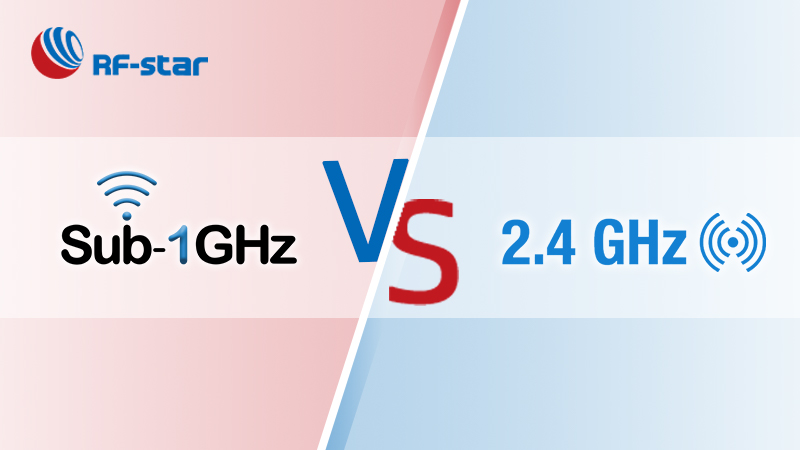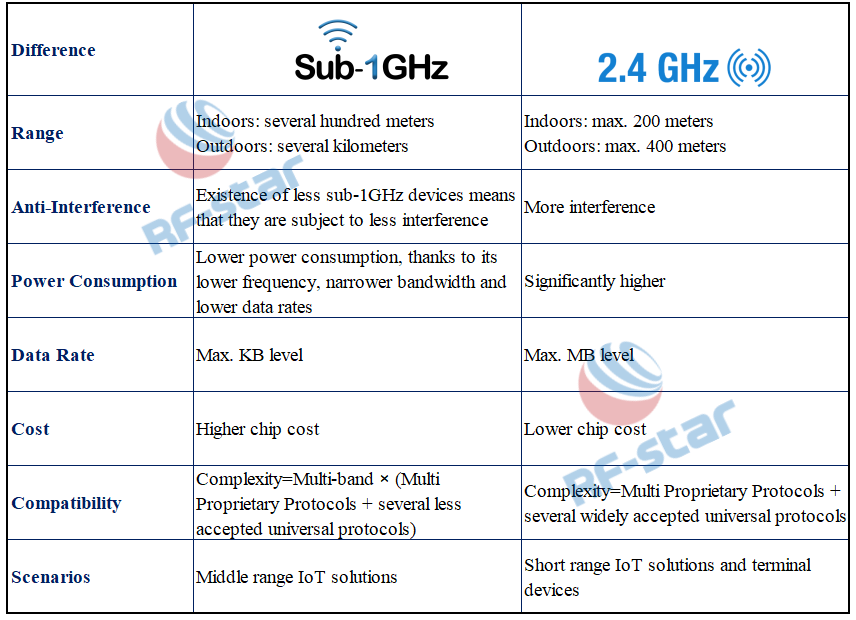When you have a clear knowledge of what is Sub-1GHz, the differences between Sub-1GHz and 2.4 GHz may puzzle you again. Here is a comparison between Sub-1GHz and 2.4 GHz radio from various dimensions such as coverage range, power consumption, interference, data rates, costs, and scenarios. It will help you trade off radio system options to achieve optimal performance or ROI for your target wireless IoT application solutions.

Figure1 Sub-1GHz vs. 2.4 GHz RF from RF-star
This blog lists and elaborates 7 major distinctions between Sub-1GHz and 2.4GHz radio which are important for you to consider before constructing your networks.

Figure2 Comparison of Sub-1GHz Vs 2.4GHz with 7 differences
1. Transmission Range of Sub-1GHz Is Superior to 2.4 GHz
Sub1 GHz radio features longer wavelengths compared to 2.4 GHz radio due to its lower frequency. Longer wavelengths mean the Sub 1GHz bands are more poised to bypass obstacles such as walls, trees, or buildings in diffraction. It also means Sub 1GHz radio waves are less prone to reflection. The characteristic also contributes to the Sub 1GHz’s advantage of lower free space path loss, enabling them to travel longer distances in open areas.
2. Compared to 2.4GHz, Sub-1GHz Signals Encounter Less Interference
Due to its extensive adoption legacy, the 2.4 GHz frequency band is congested with overlapping signals from multiple devices, including Wi-Fi routers in homes and offices, Bluetooth-enabled computers and cell phones and their peripherals, and even microwave ovens. Such a crowded environment causes significant interference. On the other hand, Sub-GHz ISM bands are typically utilized for proprietary low-duty-cycle links, resulting in less interference between different devices. The less crowded spectrum allows for smoother transmissions with fewer retries and ultimately improves efficiency and saves battery power. Should the target solution be more demanding in anti-interference performance, you ought to put more weight on Sub 1GHz radio in consideration.
3. Sub 1GHz Radio Is More Power Efficiency than 2.4GHz Ones
Systems or applications operating over Sub-1GHz bands enjoy the advantage of lower power consumption thanks to diffraction and its lower data rates. Its narrower bandwidth means reduced thermal noise, which in turn improves receiver sensitivity. When the receiver sensitivity is higher, less transmission output is required, leading to lower power consumption of the entire system. For applications highly sensitive to power efficiency such as remote sensors and low-powered IoT devices, Sub-1 GHz is the optimal choice.
4. 2.4GHz RF Offers Higher Data Transfer Rates than Sub-1GHz
In radio communications, high bandwidth is associated with a high data rate, as you can send more data per time unit. Typically, 2.4GHz radio frequency offers higher data transfer rates compared to Sub 1GHz frequency bands because of its higher frequency. This makes it suitable for applications that require higher data throughput, such as video streaming, file transfer, and online gaming.
5. 2.4GHz Chips Are Normally Less Expensive Than Sub-GHz Ones
2.4GHz is the favorite radio band for standard makers. The most popular wireless standards such as WiFi and Bluetooth both adopt 2.4GHz bands for their carrier waves. That creates an incomparable scale of economy for 2.4GHz chips, making their prices lower than Sub 1GHz chips in general.
6. It is Easier to Realize Compatibility with 2.4GHz
Sub-1GHz, as the name implies, supports 1 GHz spectrum band, typically in the 915 MHz, 868 MHz and 433 MHz frequency range. Evidently, over different bandwidths solutions cannot communicate with each other. Even for some universal standards such as LoRa and Wi-Sun, they can still not overcome this barrier under their own standard frameworks. Over 2.4GHz, compatibility is easier. One just has to select the same protocol for the solution. Even though there are different protocols in the system, it is easier to bridge different sections with a gateway.
7. Sub-1GHz vs. 2.4GHz Application Scenarios
Both Sub-1GHz and 2.4GHz technologies are expanding in the consumer, industrial and automotive marketplaces, but they are a little different in specific markets.
Data-intensive terminal devices such as smartphones, game consoles, and tablet PCs and short-range IoT solutions are preferred 2.4GHz protocols such as WiFi and Bluetooth. Less data-intensive applications such as smart meters, garage door openers (GDO) and some middle-range IoT solutions are prone to adopt Sub-1GHz, since their data rate demand is lower while range and autonomy are at higher priority in design.
To address the demands of different scenarios, some solution makers may need to build two wireless protocols in the same system. RF-star’s CC1352P multi-band Sub-1GHz and 2.4-GHz wireless module is a good choice for them. It supports Bluetooth Low Energy (BLE), Sub 1GHz, and ZigBee 3.0 protocols. For instance, while a CC1352P RF module is designed in a building security system, and its 2.4GHz radio can support video cameras, its Sub 1GHz protocol can support connecting with pressure and acceleration sensors.
Conclusion
Sub-1GHz and 2.4 GHz are popular ISM bands. In addressing the actual demand of different application scenarios, both of them respectively show different pros and cons. Sub-1GHz radio frequency excels in longer-range connectivity, lower power consumption, and reduced interference. 2.4 GHz RF is a better fit for use cases requiring higher data transfer rates within a smaller network environment.
When you have any questions about the Sub-1GHz vs. 2.4 GHz RF, feel free to contact RF-star at info@szrfstar.com.